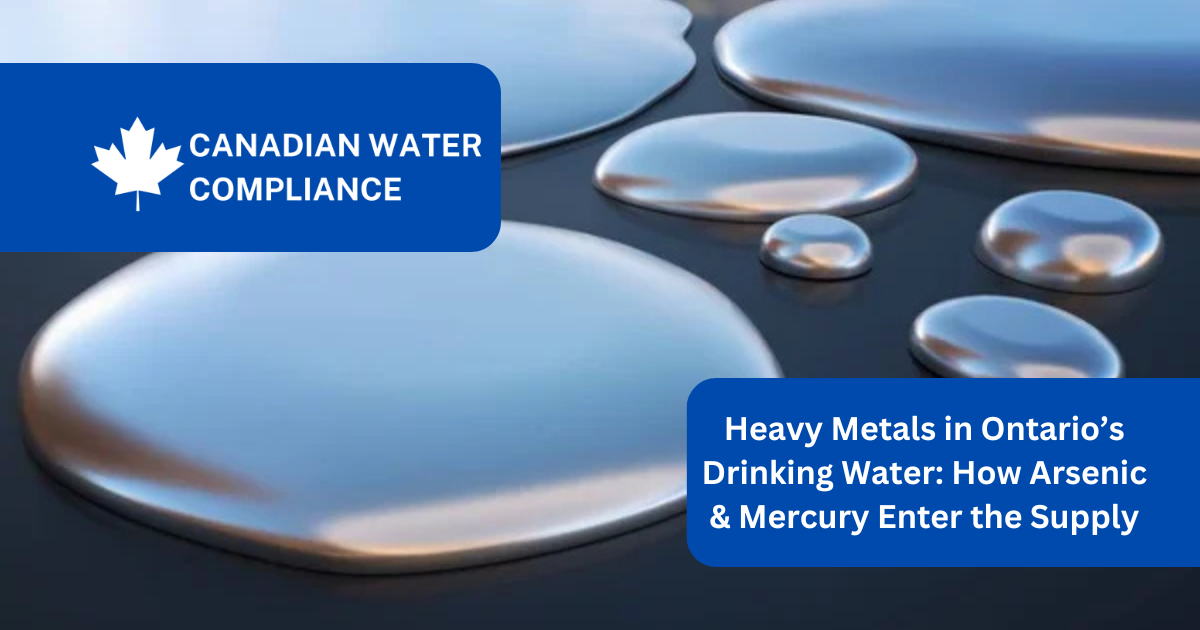
Written By: Canadian Water Compliance | On
Heavy metal contamination in drinking water is a growing concern worldwide, and Ontario is no exception. While municipal water systems are tightly regulated, heavy metals like arsenic, mercury, lead, and cadmium can still find their way into water sources—posing risks to both human health and the environment.
Some of these metals occur naturally in Ontario’s soil and bedrock, while others result from industrial pollution, mining, and aging water infrastructure. In high concentrations, heavy metals can lead to neurological damage, kidney disease, and developmental issues, making it essential for both municipal water users and private well owners to stay informed.
In this article, we’ll cover:
✅ How arsenic, mercury, and other heavy metals enter Ontario’s water
✅ Health risks associated with exposure
✅ Ontario’s regulations on heavy metal contamination
✅ How to test and remove heavy metals from drinking water
Certain regions in Ontario contain naturally high levels of arsenic, lead, and other metals due to the mineral composition of bedrock. Groundwater wells drilled into these areas may have elevated metal concentrations, especially in:
Northern Ontario (e.g., Sudbury, Timmins, Thunder Bay)
Rural areas with fractured bedrock aquifers
Coastal and lake-adjacent regions with sedimentary rock formations
Ontario has a long history of mining, smelting, and industrial activity, particularly in regions like Sudbury, Sault Ste. Marie, and Timmins.
⚠ Mercury contamination has been linked to historical gold and silver mining.
⚠ Arsenic pollution is a byproduct of metal refining and industrial waste disposal.
⚠ Cadmium and lead leach into waterways from improper waste management.
Fertilizers, pesticides, and livestock waste can introduce heavy metals into lakes, rivers, and groundwater sources. Some older pesticides contained arsenic, and manure can contribute to cadmium and zinc contamination in rural drinking water supplies.
Older municipal water systems and private homes may still contain lead pipes or solder, which can leach into drinking water. Even small amounts of lead exposure are linked to brain damage, developmental issues, and cardiovascular disease.
Improper disposal of batteries, electronics, and industrial waste can result in heavy metals leaching into nearby soil and groundwater. Many landfill sites in Ontario require leachate treatment systems to prevent contamination, but older landfills may pose risks.
🚨 Arsenic – Linked to cancer, heart disease, and neurological disorders. Long-term exposure can cause skin lesions and organ damage.
🚨 Mercury – Toxic to the nervous system. Can impair brain function, especially in children and pregnant women.
🚨 Lead – Causes permanent brain and nervous system damage, particularly in infants and young children.
🚨 Cadmium – Increases the risk of kidney disease and bone fractures with prolonged exposure.
🚨 Chromium-6 – A known carcinogen that can cause lung and liver damage.
💡 The effects of heavy metal exposure depend on concentration, length of exposure, and individual health factors. Municipal water users and private well owners should test their water regularly for contaminants.
The Ontario Drinking Water Quality Standards set maximum allowable concentrations for heavy metals in drinking water:
Heavy Metal | Maximum Acceptable Concentration (MAC) |
|---|---|
Arsenic | 0.010 mg/L (10 ppb) |
Lead | 0.005 mg/L (5 ppb) |
Mercury | 0.001 mg/L (1 ppb) |
Cadmium | 0.005 mg/L (5 ppb) |
Chromium | 0.05 mg/L (50 ppb) |
Municipalities regularly test water for these contaminants, but private well owners are responsible for their own water quality testing.
🏢 If you use city water, your local municipality tests and reports heavy metal levels. You can access this information through annual water quality reports. If you have concerns, consider additional at-home testing.
🏡 Well water is not monitored by the government, meaning it’s your responsibility to test for heavy metals. Testing should be done:
✔ At least once a year, especially if you live near industrial, mining, or agricultural areas.
✔ Immediately if water has a metallic taste, discoloration, or plumbing corrosion.
✔ Through an accredited Ontario laboratory, such as those recommended by your local health unit.
If heavy metals are detected in your drinking water, several effective filtration methods can help:
💧 Best for removing arsenic, lead, mercury, and cadmium. These systems use a membrane to filter out contaminants at the molecular level.
✅ Effective for reducing lead and mercury, but not arsenic.
🔄 Uses resin beads to capture heavy metals before they reach your tap. Commonly used in whole-house filtration systems.
🔥 Boils water and collects pure steam, leaving contaminants behind. Very effective, but slow and expensive.
🚨 Boiling water does NOT remove heavy metals—it can actually increase their concentration as water evaporates!
Heavy metals like arsenic, mercury, and lead pose a real risk to drinking water in Ontario. While municipal systems are monitored and regulated, private well owners must take extra precautions to ensure their water is safe.
✅ Test your water regularly
✅ Use proper filtration if needed
✅ Stay informed about local water quality
🔎 Need professional water testing? Contact Canadian Water Compliance for expert testing and filtration solutions!